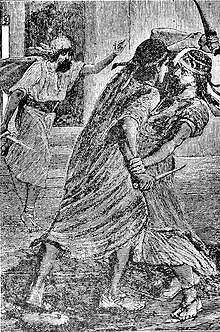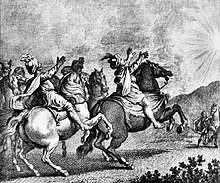Gobryas
Gobryas (Ancient Greek: Γοβρύας; Old Persian: 𐎥𐎢𐎲𐎽𐎢𐎺 g-u-b-ru-u-v, reads as Gaub(a)ruva?;[1] Elamite: Kambarma) was a common name of several Persian noblemen.
Gobryas (Cyrus the Great's general)
This Gobryas is mentioned in the Cyropedia of Xenophon as a general who helped in the conquering of Babylon.
The A.K. Grayson translation of the Nabonidus Chronicle based on that of T.G. Pinches, considers both the names Ugbaru and Gubaru found in the latter to be references to this Gobryas. However the names are distinct in the text and refer to two different individuals, the one called Gubaru being the ruler placed over Babylon thus corresponding to Cyaxares of the Cyropedia (and the Darius the Mede of the Bible) not Gobryas. Ugbaru remains a candidate for Gobryas being described as the ruler of the region of Gutium dying soon after the conquest of Babylon similarly to Xenophon's portrayal of Gobryas as an elderly "Assyrian" ruler. According to William H. Shea Ugbaru and Gubaru is the same person, being the ruler placed over Babylon, dying soon after the conquest of Babylon.[2]
Gobryas (the lance-bearer of Darius the Great)


This Gobryas was one of the six helpers of Darius in killing Gaumāta in September 522 mentioned by Herodotus. He was appointed as Darius' lance carrier (arštibara). He is represented on the Behistun inscription and on Darius' tomb in Naqsh-e Rustam, as:[4]
Gaubaruva \ Pâtišuvariš \ Dâra
yavahauš \ xšâyathiyahyâ \ arštbara
Gobryas from Pâtišuvariš, the lance carrier of king Darius.[4][5]
Pâtišuvariš may be the mountainous region north of Alborz in northern Iran, probably Mazandaran.[6][7] In 521, he was sent to Elam to defeat the rebel king Atamaita;[8] after this, he served as satrap of Elam.
Gobryas' family was closely entwined with the family of Darius the Great. Gobryas married the sister of Darius[9], known variously as Artazostre or Radušdukda. Their son Mardonius, was the Commander-in-Chief of the armies of Xerxes I in the Second Persian invasion of Greece, married Darius' daughter Artazostre. A daughter of Gobryas, from an earlier marriage, was married to Darius.[10]
References
- http://www.iranicaonline.org/articles/gaubaruva-
- The Search for Darius the Mede; Journal of the Adventist Theological Society, 12/1 (Spring 2001)
- Baddeley, Sam; Fowler, Paul; Nicholas, Lucy; Renshaw, James (2017). OCR Ancient History GCSE Component 1: Greece and Persia. Bloomsbury Publishing. p. 30. ISBN 9781350015173.
- Kuhrt, Amélie (2013). The Persian Empire: A Corpus of Sources from the Achaemenid Period. Routledge. p. 450. ISBN 9781136017025.
- DNc - Livius.
- "Pâtišuvariš" (in Persian). Encyclopaediaislamica.com. Archived from the original on 2010-11-04.
- ITshomal.com. "پتشخوارگر". Mazandnume.com. Retrieved 2012-10-27.
- Darius; Leonard William King; Reginald Campbell Thompson; Ernest Alfred Wallis Budge (1907). The sculptures and inscription of Darius the Great: on the rock of Behistûn in Persia. London: British museum. pp. 78-81. (Behistun Inscription, paragraph 71)
- Herodotus 7.5.1
- Jona Lendering. "Gobryas". Livius.org. Retrieved 2012-10-27.
- T. Gaston, Historical Issues in the Book of Daniel, 2009

